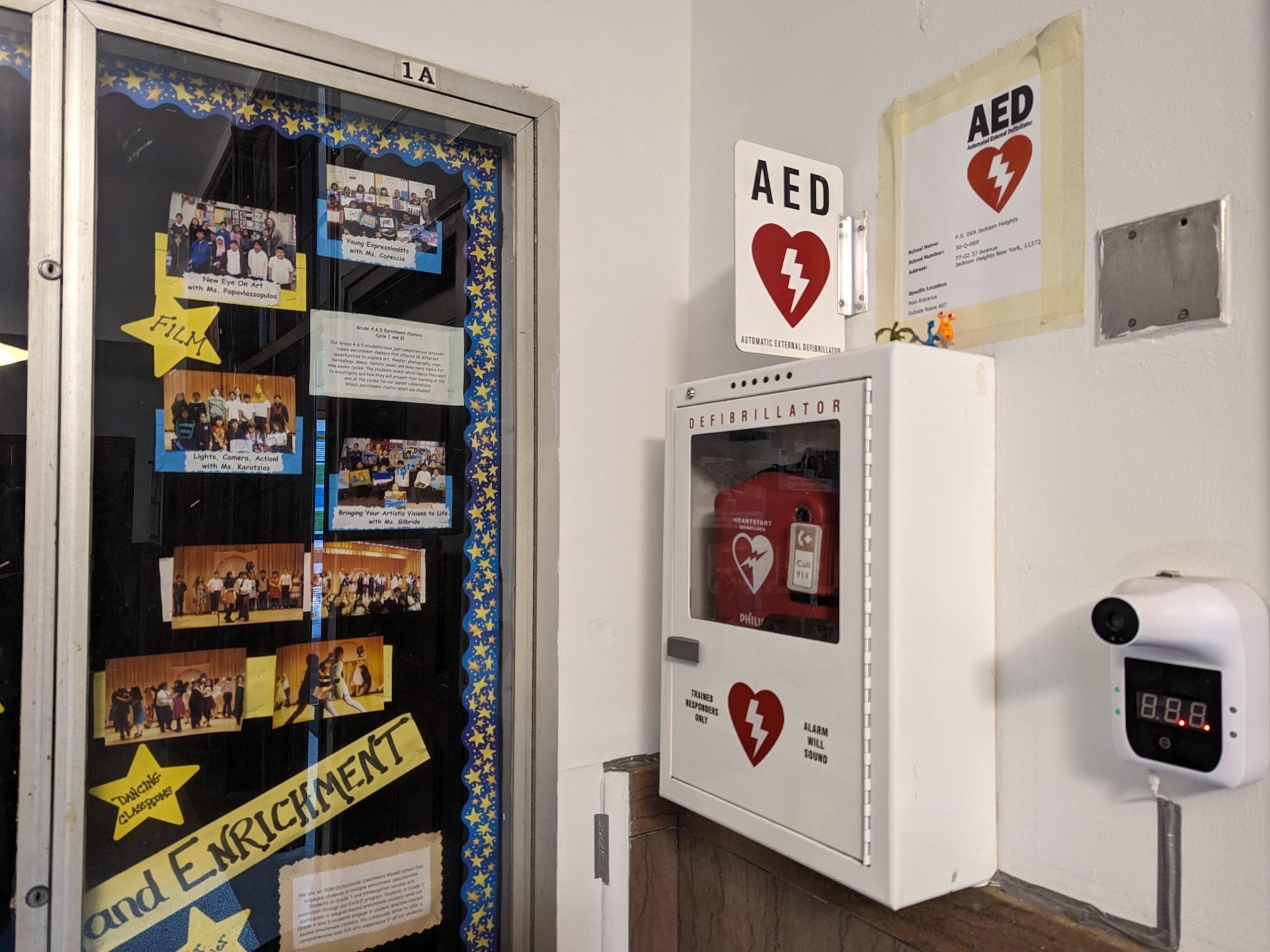
An AED in P.S. 69, Jackson Heights, Queens
In January, America watched in horror as Buffalo Bills safety Damar Hamlin collapsed onto the field, moments after making a routine tackle during a game against the Cincinnati Bengals. Twenty-four years old and in peak physical health, Hamlin had suffered a sudden cardiac arrest in front of thousands in the stands and millions tuned into Monday Night Football.
Thanks to good planning and training, the Bills' medical team on the sidelines had an automatic external defibrillator on hand, commonly known as an AED. Within seconds, these first responders used the AED to shock Hamlin's heart back into a normal rhythm as he awaited transport to a local hospital. The device not only saved his life, it also restored blood flow quickly enough to prevent permanent damage to his brain. Later that same month, Damlin was able to cheer on his team from the sidelines in its rematch against the Bengals. Today, he is back on the field, and his resilience and infectious optimism are an inspiration for us all.
As Damar’s story makes clear, AEDs save lives. Unfortunately, however, they aren't as readily accessible for everyone as they were for him. They should be, and we're both sponsoring legislation – on the federal and municipal levels – to make sure they are.
Each year, more than 356,000 people in the United States suffer cardiac arrest outside of the hospital, including more than 7,000 children. What the nation witnessed during Monday Night Football in January happens every day in our schools, playgrounds, and parks. A basketball player collapses after taking a rough shoulder check. A teacher trips and stumbles in the hallway clutching her chest. A high schooler falls to the grass after making a tackle during football practice.
In these terrifying situations, the evidence of AEDs' effectiveness is as impressive as it is unequivocal. According to the American Heart Association, the chance of survival for someone experiencing cardiac arrest outside of the hospital is less than 10%. That jumps to an average 40% survival rate when professional first responders like firefighters or emergency medical technicians use an AED. Incredibly, the chance of survival is highest when non-professional first responders use an AED: greater than 50%.
This is because non-professional bystanders – often coaches, teachers, or friends – can respond much more quickly than even the fastest ambulances in the critical moments right after the start of an irregular heart rhythm. It's also because modern AEDs are semi- or fully-automated. They provide clear verbal, and often visual, instructions that an average person can follow with only basic training.
The life-saving benefits of AEDs are obvious, which is why they have been placed in more and more public locations over the last several decades. President Clinton signed the Cardiac Arrest Survival Act in 2000, placing the devices in federal buildings and providing millions in grants for local deployment. Two years later, President Bush signed the Community Access to Emergency Devices Act, allocating millions more for states and localities to purchase AEDs and train first responders in their use. Besides the federal government, 20 states – including our own state of New York – require placement of AEDs in all public schools. But progress has stalled in recent years.
Hamlin's cardiac arrest makes a clear call to action: we must enact legislation to expand access to even more communities. At the federal level, Leader Schumer’s bipartisan Access to AEDs Act will provide grants to place devices in elementary and secondary schools nationwide, and will fund the development of school-based cardiac emergency response plans. And in New York City, Council Member Krishnan’s HEART (Harihareswara Expand Access to Rapid Treatment) Act will require the Department of Health to publish online the precise locations and quantities of all publicly-accessible AEDs within the five boroughs, whether in schools, firehouses, or government office buildings. If loaded into common mapping apps on our smartphones, this data can make AEDs as quick and easy to find as a cup of coffee.
Together, these laws can ensure that these miraculous devices are immediately accessible where most cardiac arrests occur – not in pro sports stadiums, but near our rec centers, public ballfields, and school yards. With easy-to-locate, ubiquitous AEDs, we can save countless people from cardiac death, from elite athletes like Damar Hamlin to ordinary New Yorkers like us.
***
Charles Schumer is the U.S. Senate Majority Leader. Shekar Krishnan is a City Council Member representing parts of Queens. On Twitter @SenSchumer & @voteshekar.
***
Have an op-ed idea or submission for Gotham Gazette? Email This email address is being protected from spambots. You need JavaScript enabled to view it.